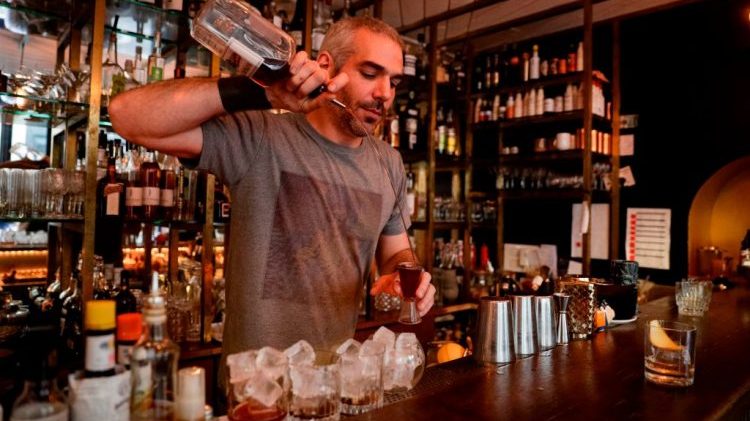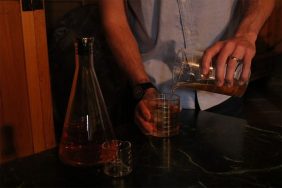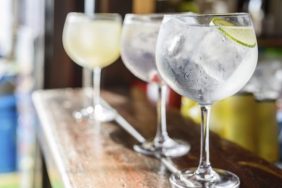Photo: GEOFFROY VAN DER HASSELT/AFP/Getty Images
Cocktails, as we know them, have been shaken, stirred, and built since the 1800s. During the 200-plus years since then, most of the ingredients have stayed more or less the same. When you look at the basic makeup of a cocktail, you’ve got your various herbs, simple syrup, bitters, and spirits. Throw in your shrubs, tinctures, fresh produce, and random flavors and you pretty much have everything covered. But, in recent years, with the mixology boom, bartenders have begun to look to stronger, complicated, and downright strange ingredients to give their cocktails a fresh, new flavor. It’s getting increasingly difficult to break new ground in an industry saturated with creative people.
If you’re anything like us, you’re wondering what strange ingredients your favorite bartenders use to elevate their cocktails. We asked some well-known bartenders to tell us the strangest ingredients they’ve encountered recently.
“I’m noticing more and more herbs and exotic spiced syrups like harisa, sumac, birch syrup, pink peppercorns, epazote, just to name a few. Some bar programs are infusing the botanicals into the alcohol, some are muddling or using as garnish. I’m using some of them in my fall menu: I’m putting birch syrup in a gin and sage cocktail called ‘Army of Me’ and epazote-infused tequila and corn for a new spin on a margarita.” – Johnny Swet, bartender at Grand Republic Cocktail Club in Brooklyn, New York
“Flavored bitters, either house-made or purchased, have been around for a while, but recently in Phoenix, I’ve begun to see interesting examples, such as figgy pudding or jalapeño, or bartenders using three to four different types in one cocktail. Additionally, we’ve been experimenting with a cocktail with SPAM. Basically, we’re trying to do a fat wash with the spirit with SPAM and create a cocktail for the fall menu. With the Wrigley Mansion’s tie to the Hormel family (its current owner, Jamie Hormel, is the widow of Geordie Hormel, the son of the man who invented SPAM), it feels like a great way to honor our heritage.” – Ben Sinon, general manager of the Wrigley Mansion in Phoenix
“The strange ingredients we’re seeing are miso and turmeric – both contributing the unusual tinge of earthy flavor.” – Kevin Parisi, bartender at Quill in Washington, DC
“Fat washing is a frontier bars have been on the edge of for a while. It’s been off limits to higher volume, less cocktail-focused crowds so far, but here comes the fall, and with it comes turkey fat, beef fat, and what do they call it: confit. Be prepared for fat washing to be more and more common as the average drinking is more educated than ever, and with that, new territory must be explored.” – Josh Cameron, head bartender at Boulton & Watt in New York City
Drink Smarter: Everything You Ever Wanted To Know About Cognac
“Vermouth, the European aromatized wine – generally French, Italian, and Spanish – has been a café luxury of Hemmingway’s ‘Lost Generation.’ It was originally consumed straight or diluted with other liquids to create a tonic beverage to stimulate the appetite and enhance digestion. Over the centuries, however, vermouths have been used as flavoring ingredients in cocktails. Vermouth has certainly fallen out of favor with most people these days. Yet, now they constitute a variety of classic iconic cocktails (the martini doesn’t work without it). By definition, vermouth is a wine base aromatized with some version of the Artemisia herb, along with other approved natural herbs, fruits, spices, or flavorings. As a component in a cocktail, it adds either a dry herbaceous citrus character or a rustic wine-y sweetness with spice and a slight bitterness. In Lumber Baron we make Chamberyzette during the summer, which blends dry French vermouth with the juice of wild strawberries. I encourage my guests to try Carpano Antica Formula, which is a high end Torino-Style red vermouth created from a resurrected ancient recipe and has a high amount of natural vanilla added and favors floral and spice over herbal components.” – Jeremy Williams, lead mixologist at Lumber Baron Bar in Grand Rapids, Michigan
“At Aloft Miami Aventura, Aquafaba (a.k.a. chickpea water), has been trending. We use the ingredient in our ‘Merry Berry’ cocktail.” – Jennifer Arroyo, bartender at Aloft Miami Aventura
“In Hawaii, and especially at Mahina & Sun’s, sourcing local and seasonal ingredients is of highest priority and conveniently doubles as a way to showcase unique and new tastes, textures, aromas, and sights via cocktails. Our upcoming fall menu will feature various shrubs, dehydrated garnishes, and vegetable juices versus citrus juices. I have been lucky to parallel with the Surfjack, Mahina & Sun’s, and Chef Ed Kenney’s style, and my personal philosophy of sustainable bartending: let nothing go to waste while sourcing as many ingredients from local farms as possible. I have noticed a growing trend in the bartending realm using butterfly pea tea, beets, figs, calamansi, and activated charcoal, as well as a large interest in mezcal, single batch spirits, and in-house infusions.” – Ross Lewis, bar lead at Mahina & Sun’s at The Surfjack Hotel & Swim Club in Honolulu, Hawaii
Ask The Pros: Bartenders’ Favorite Beach Beers
“Everything bagel seasoning. It’s everywhere from bar snacks to drink rims and frankly, I’m loving it! It’s already a staple of every real New Yorker’s diet, and now without all those carbs! You can customize it to bring out your own favorite parts. My personal blend has a bit more salt than most people are using, as well as a healthy dose of caraway seeds. I keep a mix at home for cooking, and it makes for a perfect addition to Bloody Marys.” – Mikey Diehl, head bartender at Drexler’s in New York City
“Passoã is a bright pink passion fruit liqueur that’s made in France and that’s been popular in Europe for a while now. Since it launched in the U.S. last year, we’ve been using it in all kinds of drinks because of its versatility. That versatility means you don’t necessarily have to have amazing technique to make a great drink. Plus, Passoã is only 20 percent alcohol, so it works with the low ABV trend. We keep it simple with fun stuff like passion fruit margarita or a simple sangria: 1 part Passoa, 2 parts rose wine, add some fresh berries and orange slices and serve over ice. Instant party.” – Ryan Brown, bartender at Fine and Dandy in Tampa, Florida
“One of the strangest (and most fun) ingredients popular in the cocktail world at the moment is CBD. CBD is an extract from cannabis, which is legal in the U.S. It has no THC and therefore has a relaxing effect when consumed. I have the pleasure of using CBD in several cocktails at The Williamsburg Hotel, including ‘If You Like Piña Colada,’ which is made with infused CBD oil singani 63.” – Rael Petit, beverage director at The Williamsburg Hotel in Brooklyn, New York









